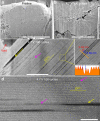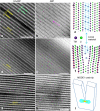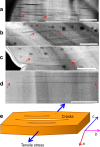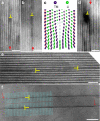Intragranular cracking as a critical barrier for high-voltage usage of layer-structured cathode for lithium-ion batteries
- PMID: 28091602
- PMCID: PMC5241805
- DOI: 10.1038/ncomms14101
Intragranular cracking as a critical barrier for high-voltage usage of layer-structured cathode for lithium-ion batteries
Abstract
LiNi1/3Mn1/3Co1/3O2-layered cathode is often fabricated in the form of secondary particles, consisting of densely packed primary particles. This offers advantages for high energy density and alleviation of cathode side reactions/corrosions, but introduces drawbacks such as intergranular cracking. Here, we report unexpected observations on the nucleation and growth of intragranular cracks in a commercial LiNi1/3Mn1/3Co1/3O2 cathode by using advanced scanning transmission electron microscopy. We find the formation of the intragranular cracks is directly associated with high-voltage cycling, an electrochemically driven and diffusion-controlled process. The intragranular cracks are noticed to be characteristically initiated from the grain interior, a consequence of a dislocation-based crack incubation mechanism. This observation is in sharp contrast with general theoretical models, predicting the initiation of intragranular cracks from grain boundaries or particle surfaces. Our study emphasizes that maintaining structural stability is the key step towards high-voltage operation of layered-cathode materials.
Figures







References
-
- Sathiya M. et al.. Origin of voltage decay in high-capacity layered oxide electrodes. Nat. Mater. 14, 230–238 (2015). - PubMed
-
- Lin F. et al.. Surface reconstruction and chemical evolution of stoichiometric layered cathode materials for lithium-ion batteries. Nat. Commun. 5, 3529 (2014). - PubMed
-
- Xu B., Fell C. R., Chi M. F. & Meng Y. S. Identifying surface structural changes in layered Li-excess nickel manganese oxides in high voltage lithium ion batteries: a joint experimental and theoretical study. Energy Environ. Sci. 4, 2223–2233 (2011).
-
- Yan P. et al.. Evolution of lattice structure and chemical composition of the surface reconstruction layer in Li1.2Ni0.2Mn0.6O2 cathode material for lithium ion batteries. Nano Lett. 15, 514–522 (2015). - PubMed
-
- Zheng J. et al.. Corrosion/fragmentation of layered composite cathode and related capacity/voltage fading during cycling process. Nano Lett. 13, 3824–3830 (2013). - PubMed
Publication types
LinkOut - more resources
Full Text Sources
Other Literature Sources
Molecular Biology Databases

